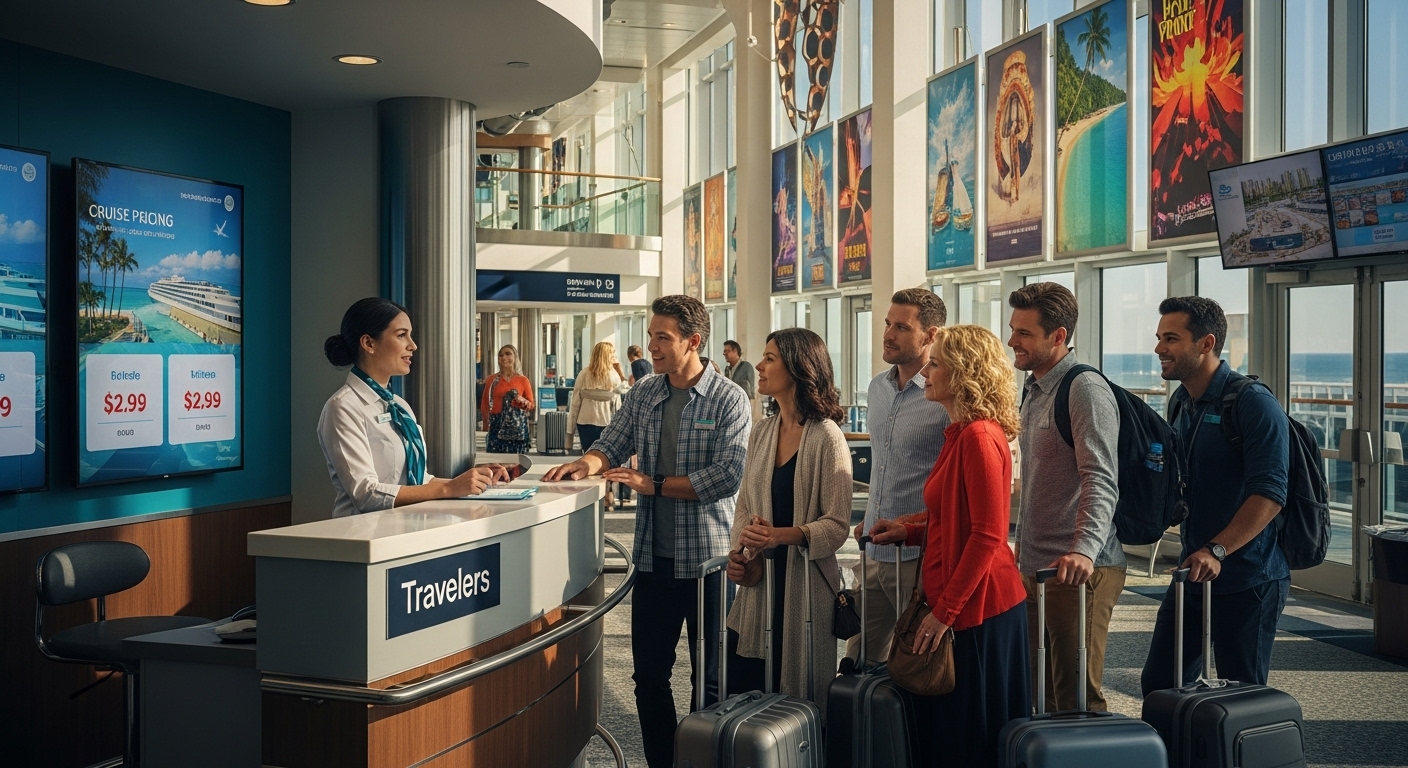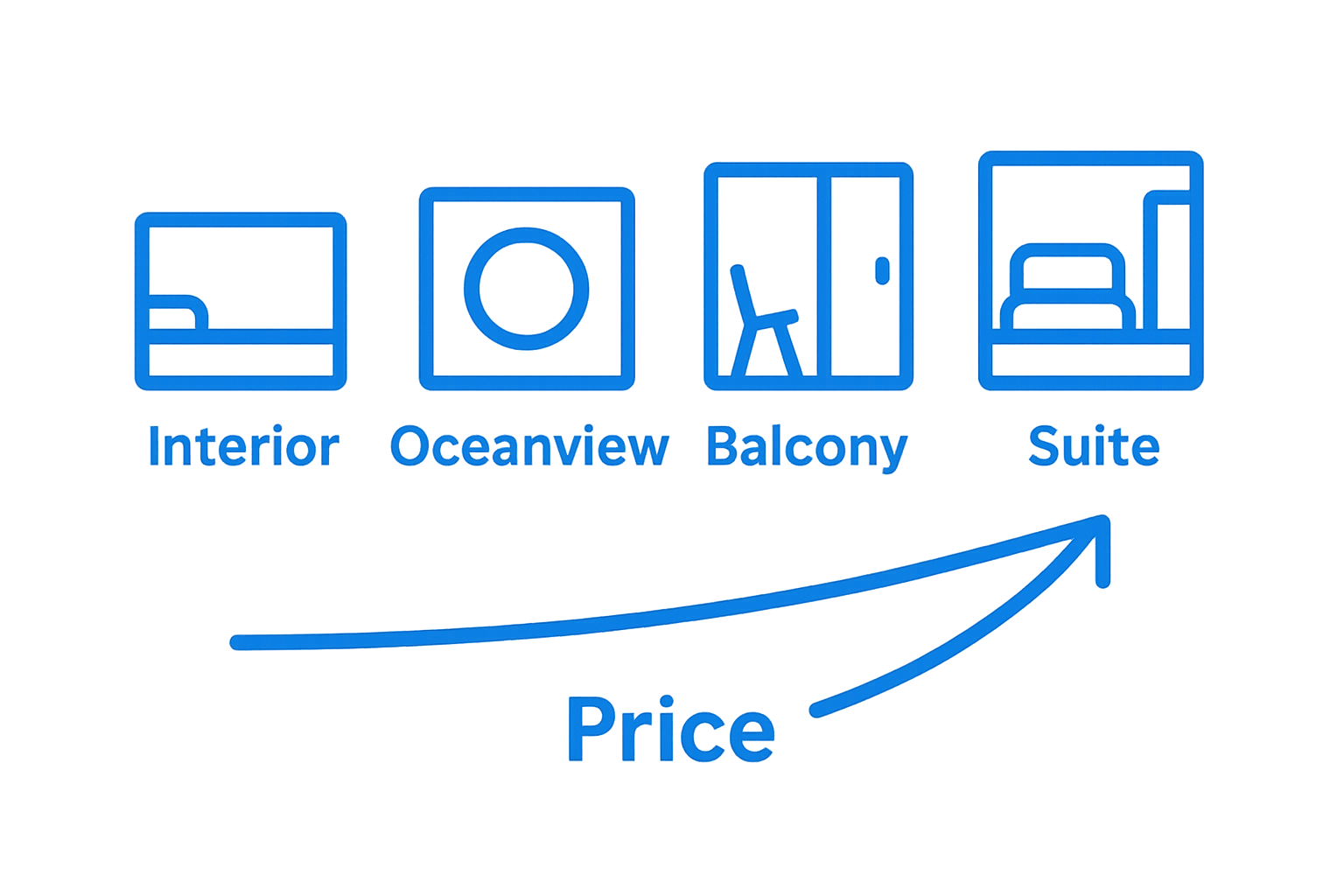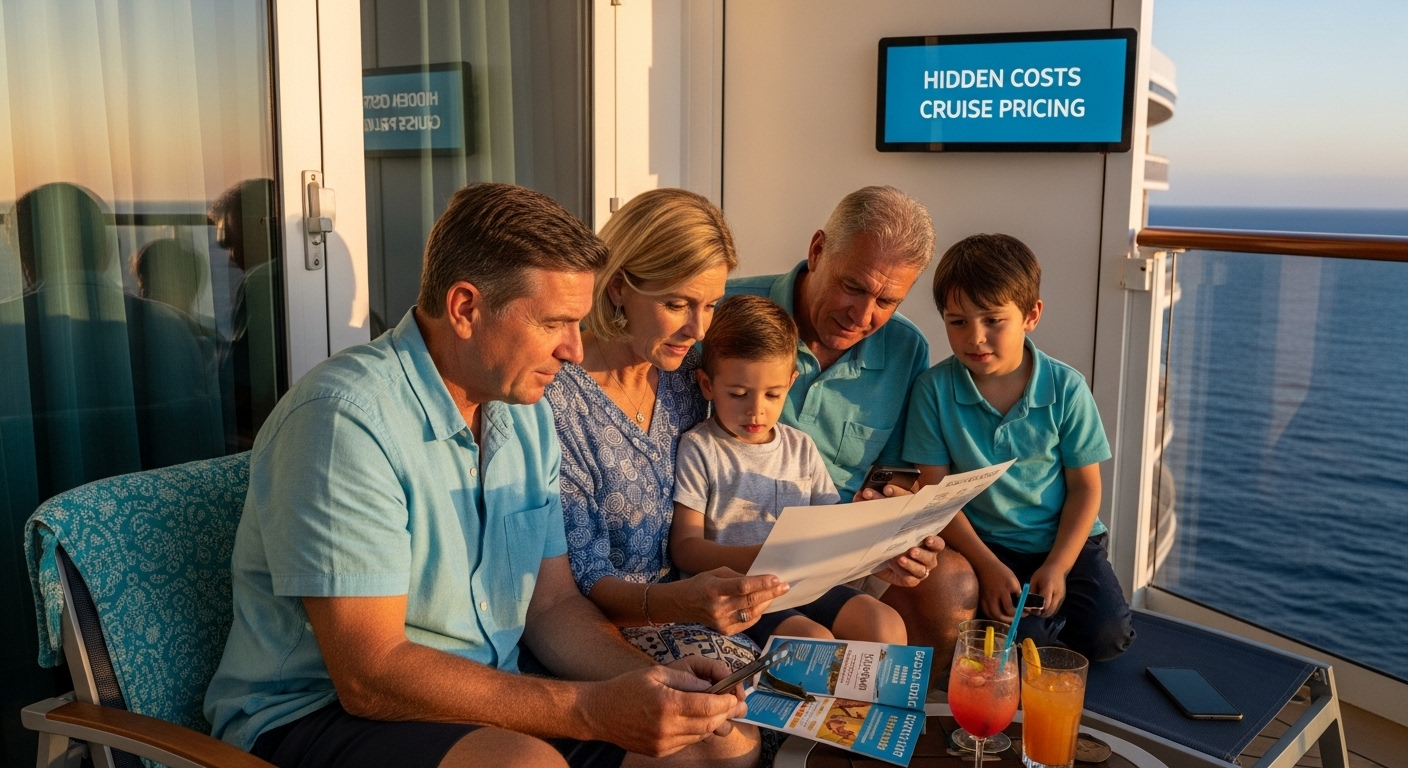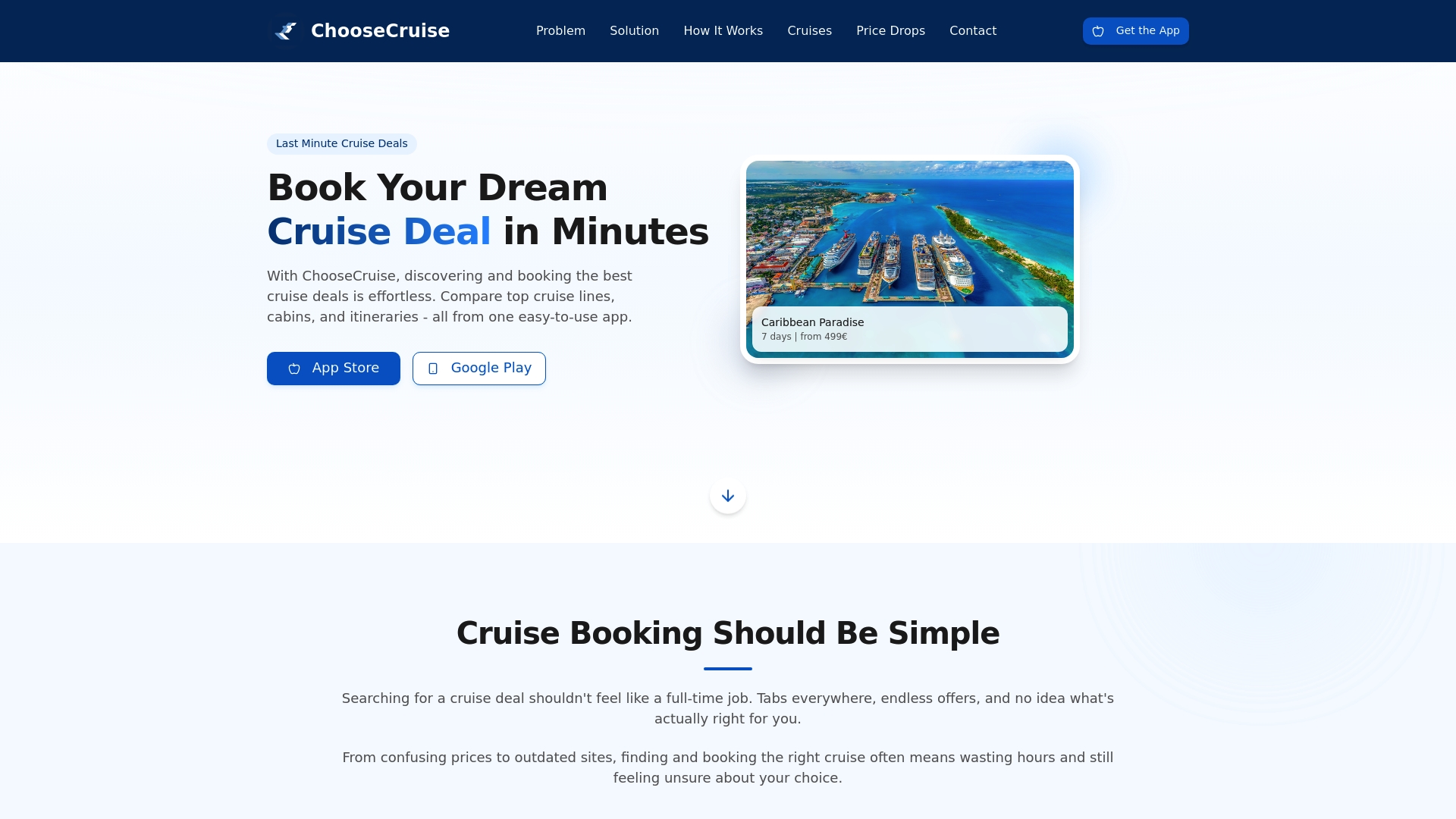Understanding How Cruise Deals are Priced for Travelers

Cruise deals are everywhere and they look like a ticket to paradise for less. Travelers see tempting offers but sticker shock often follows when they realize the true costs. Did you know hidden fees and extra charges can add over 30 percent to your cruise price? The real surprise is that understanding the timing, fare types, and these secret expenses could save you more than any early bird discount ever could.
Table of Contents
- What Influences Cruise Pricing?
- The Role Of Demand And Supply In Cruise Deals
- Understanding Fare Types And Inclusions In Pricing
- How Timing Affects Cruise Prices
- Hidden Costs And Their Impact On Overall Pricing
Quick Summary
| Takeaway | Explanation |
|---|---|
| Travel During Shoulder Seasons for Savings | Booking cruises in shoulder seasons can lead to significantly lower prices compared to peak travel times. |
| Understand Cabin Categories for Budgeting | Choose the right cabin type; interior cabins are most affordable, while suites offer luxury at higher costs. |
| Be Aware of Hidden Costs Onboard | Plan for additional expenses like dining upgrades and service charges that are often not included in the base fare. |
| Book Early or Look for Last-Minute Deals | Early birds can secure discounts, while spontaneous travelers might find attractive last-minute offers if available. |
| Monitor Demand for Pricing Changes | Price adjustments happen due to changes in demand; awareness of peak holidays can help you plan better. |
What Influences Cruise Pricing?
Understanding how cruise deals are priced requires unpacking multiple complex factors that determine the overall cost. Cruise pricing is a sophisticated system influenced by numerous variables that can significantly impact what travelers ultimately pay.
Seasonal and Timing Dynamics
The timing of your cruise plays a critical role in pricing. Peak travel seasons like summer and winter holidays command higher prices due to increased demand. Cruise pricing strategies reveal that shoulder seasons—periods between peak and off-peak times—often offer more attractive pricing. These transitional periods allow travelers to experience desirable destinations at more affordable rates.
Cruise lines strategically adjust prices based on:
- Historical booking patterns
- Anticipated travel demand
- Local event calendars
- School holiday schedules
Cabin Selection and Accommodation Tiers
Your choice of accommodation dramatically influences the total cruise cost. Cruise ships offer multiple cabin categories with distinct pricing structures. Interior cabins represent the most economical option, providing basic accommodation without ocean views. Oceanview and balcony cabins incrementally increase in price, offering enhanced experiences and visual access to maritime landscapes.
Accommodation tiers typically include:
To clarify the differences between cruise cabin categories and help travelers make informed budgeting decisions, the following table compares each cabin type featured in the article.
| Cabin Category | Price Level | Features/Description |
|---|---|---|
| Interior Cabin | Most affordable | Basic accommodation, no ocean view |
| Oceanview Cabin | Moderate | Window view of the sea |
| Balcony Cabin | Premium | Private outdoor balcony, enhanced experience |
| Suite | Highest | Spacious layout, luxury amenities |

- Interior Cabins: Most budget-friendly
- Oceanview Cabins: Moderate pricing with sea perspectives
- Balcony Cabins: Premium pricing for private outdoor spaces
- Suites: Highest price point with luxury amenities
Additional Pricing Considerations
Beyond seasonal timing and cabin selection, cruise pricing incorporates multiple supplementary factors. Destination complexity, cruise line reputation, onboard amenities, and current market competition all contribute to final pricing. For travelers seeking the best deals, understanding these nuanced pricing mechanisms becomes crucial in making informed booking decisions.
The intricate process of cruise pricing reflects a delicate balance between traveler preferences, operational costs, and market dynamics.
The Role of Demand and Supply in Cruise Deals
Navigating the complex world of cruise pricing requires understanding the fundamental economic principles of demand and supply. These interconnected dynamics significantly shape how cruise lines price their voyages, creating a sophisticated marketplace where traveler preferences and industry capacity constantly interact.
Supply Side Dynamics
The cruise industry operates with substantial fixed costs, including vessel maintenance, crew salaries, and fuel expenses. As research from industry experts indicates, cruise lines must carefully manage their fleet capacity to maintain profitability. When more ships are available in specific routes or regions, competition intensifies, potentially driving prices down.
Key supply factors influencing cruise pricing include:
- Total number of available ships
- Route complexity and destination accessibility
- Seasonal vessel deployment
- Operational maintenance schedules
Demand Fluctuations and Pricing Strategies
Traveler demand represents a critical component in cruise pricing mechanisms. Cruise lines employ sophisticated algorithmic pricing models that adjust ticket costs in real-time based on booking patterns. Popular routes, specific sail dates, and emerging travel trends can dramatically impact pricing. Our price tracking guide helps travelers understand these nuanced pricing shifts.
Demand influences manifest through:
- Peak travel seasons
- Cultural and holiday travel periods
- Economic consumer confidence
- Emerging destination popularity
Market Balance and Consumer Opportunities
The interplay between supply and demand creates unique opportunities for strategic travelers. Cruise lines continuously balance their fleet capacity with consumer interest, often offering promotional rates during periods of lower anticipated bookings. Understanding these market dynamics allows savvy travelers to identify potential deals and optimize their cruise booking strategies.
Ultimately, cruise pricing represents a complex ecosystem where economic principles, consumer behavior, and industry logistics converge to determine the final ticket price.
Understanding Fare Types and Inclusions in Pricing
Cruise fare structures represent a complex landscape of pricing options designed to cater to diverse traveler preferences and budgets. Understanding these nuanced pricing models helps travelers make informed decisions and maximize their cruise experience.
Base Fare and Fundamental Inclusions
The base cruise fare represents the foundational price point for a voyage, typically covering essential accommodations and core services. Cruise pricing strategies reveal that most base fares include fundamental amenities such as:
- Cabin accommodation
- Standard dining in main restaurants
- Basic onboard entertainment
- Access to primary swimming pools
- Scheduled daytime activities
However, travelers should recognize that base fares often do not encompass all potential expenses, requiring careful budget planning for additional services.
Tiered Fare Structures
Modern cruise lines have developed sophisticated fare tiers that offer increasing levels of inclusivity and convenience. These structured pricing models allow travelers to select packages aligning with their specific travel preferences and financial considerations.
This table summarizes the typical cruise fare types discussed in the article along with their level of inclusions, enabling easy comparison for travelers considering different pricing options.
| Fare Type | Price Level | Inclusions Description |
|---|---|---|
| Saver Fares | Most economical | Minimal inclusions, basic necessities |
| Standard Fares | Moderate | Balanced pricing, moderate amenities |
| Premium Fares | High | Enhanced benefits, more services |
| All-Inclusive Fares | Highest | Most comprehensive, nearly all services included |
Typical fare categories include:
- Saver Fares: Most economical option with minimal inclusions
- Standard Fares: Balanced pricing with moderate amenities
- Premium Fares: Comprehensive packages with enhanced benefits
- All-Inclusive Fares: Maximum coverage with virtually all services included
Additional Costs and Considerations
Beyond the initial fare structure, travelers must account for supplementary expenses that can significantly impact overall trip cost. Our comprehensive cruise booking guide recommends carefully evaluating potential additional charges such as gratuities, specialty dining, alcoholic beverages, shore excursions, and personal services.
Understanding the intricate details of cruise fare types empowers travelers to make strategic booking decisions, ensuring a transparent and financially predictable vacation experience.
How Timing Affects Cruise Prices
Timing represents a critical factor in cruise pricing, with potential variations that can significantly impact travelers’ budgets. Understanding the nuanced relationship between sail dates and pricing strategies helps travelers make informed booking decisions and potentially secure substantial savings.
Peak Season vs. Off-Peak Variations
Cruise pricing strategies demonstrate that seasonal demand dramatically influences ticket prices. Peak travel periods like summer holidays, Christmas, and school break weeks command premium rates due to high consumer interest. Conversely, shoulder and off-peak seasons offer more attractive pricing structures for budget-conscious travelers.
Key seasonal pricing factors include:
- School holiday schedules
- Major cultural and religious festivals
- Regional weather patterns
- International travel trends
Advanced Booking and Last-Minute Dynamics
Cruise lines employ sophisticated pricing algorithms that adjust fares based on booking timelines. Early bookings often provide advantageous rates, with some cruise companies offering significant discounts for passengers who reserve well in advance. Simultaneously, last-minute deals can emerge when ships have unsold cabins, creating opportunities for spontaneous travelers.
Booking timeline strategies involve:
- Early Bird Discounts: Reserving 6-12 months ahead
- Promotional Window: Special pricing during specific marketing periods
- Last-Minute Deals: Potential significant discounts close to sail date
Destination and Itinerary Considerations
Destination-specific timing plays a crucial role in cruise pricing. Some routes experience predictable price fluctuations based on regional events, weather conditions, and tourist seasons. Our cruise deals blog emphasizes the importance of understanding these destination-specific pricing nuances.
Careful timing strategy can transform cruise pricing from a potential financial challenge into an opportunity for smart, cost-effective travel experiences.
Hidden Costs and Their Impact on Overall Pricing
Cruise travelers often encounter unexpected expenses that can substantially inflate their initial budget. Understanding these hidden costs is crucial for financial planning and preventing unwelcome financial surprises during a vacation that should be relaxing and enjoyable.
Onboard Dining and Beverage Expenses
Cruise dining options reveal a complex landscape of complimentary and premium dining experiences. While basic dining venues are typically included in the base fare, specialty restaurants and premium culinary experiences come with additional charges. Beverage packages represent another significant potential expense, with alcoholic drinks, specialty coffees, and premium non-alcoholic beverages often requiring separate purchase.
Common additional dining and beverage expenses include:
- Specialty restaurant surcharges
- Premium cocktail and wine selections
- Gourmet coffee and smoothie charges
- Late-night room service fees
Mandatory and Optional Service Charges
Gratuities and service charges constitute a substantial hidden cost that many first-time cruisers overlook. Most cruise lines automatically add daily service charges to passenger accounts, covering tips for housekeeping, dining, and other crew members. These charges can range from $14 to $18 per person, per day, quickly adding up for multi-day voyages.
Additional service-related expenses encompass:
- Mandatory crew gratuities
- Optional individual tipping
- Shore excursion guide tips
- Spa and salon service gratuities
Technology and Personal Services
Modern cruise experiences offer numerous technological and personal service add-ons that can significantly impact overall pricing. Internet packages, which are increasingly essential for travelers, often come at premium rates. Personal services like spa treatments, fitness classes, and specialized entertainment experiences represent additional potential expenses.
Our cruise booking tips recommend carefully reviewing all potential additional costs before finalizing a booking. Proactive budgeting and understanding these hidden expenses can help travelers avoid financial stress and enjoy a more predictable vacation experience.

Tired of Hidden Costs and Confusing Cruise Prices? Let ChooseCruise Simplify Your Search
Struggling to make sense of cruise pricing layers, fare types, and those surprising extra fees? You are not alone. Many travelers, especially first-timers and busy families, feel overwhelmed by constantly shifting prices, unpredictable inclusions, and the stress of not knowing if they are getting the best deal. The article you just read highlighted how cruise pricing is impacted by seasons, demand and supply, and numerous add-ons. That complexity makes finding the right cruise feel frustrating, time-consuming, and even risky for your wallet.

You do not have to face this challenge alone. ChooseCruise streamlines the entire experience with real-time price tracking, AI-powered recommendations, and transparent breakdowns of what is included in every deal. Use our price drops guide to spot smart savings. Explore expert booking tips that help you avoid hidden fees and maximize value. Discover a seamless, modern approach to booking cruises that puts clarity and control back in your hands. Visit ChooseCruise now to plan your next adventure with confidence before the next fare increase or promotion ends.
Frequently Asked Questions
What factors influence the pricing of cruise deals?
Cruise pricing is influenced by various factors including seasonal demand, cabin selection, onboard amenities, and market competition. Peak travel seasons see higher prices due to increased demand, while shoulder seasons often offer more attractive rates.
How does cabin selection impact the overall cost of a cruise?
Your choice of cabin significantly influences the total cost of a cruise. Interior cabins are the most economical option, whereas oceanview, balcony cabins, and suites come with increasing price points due to upgraded experiences and amenities.
What are the hidden costs associated with cruising?
Cruisers often encounter hidden costs such as specialty dining fees, beverage charges, mandatory gratuities, and additional service expenses like spa treatments. It’s important to budget for these additional costs beyond the base fare.
How does timing affect cruise prices?
Timing plays a crucial role in cruise pricing. Advanced bookings can lead to lower fares, while last-minute deals may be available for unsold cabins. Additionally, prices vary between peak and off-peak seasons due to demand fluctuations.
Recommended
Related reading
7 Smart Ways to Save on Cruises for Modern Travelers
Discover 7 smart ways to save on cruises with easy, practical tips designed for today’s digital cruise travelers. Learn to maximize value and minimize costs.
Understanding Why Choose River Cruises for Travel Fun
Discover why choose river cruises as your next adventure. Explore their benefits, unique experiences, and how they enhance travel enjoyment.
Understanding the Best Cruise Lines for Beginners
Discover the best cruise lines for beginners, understanding what they offer and why they matter for first-time cruisers.